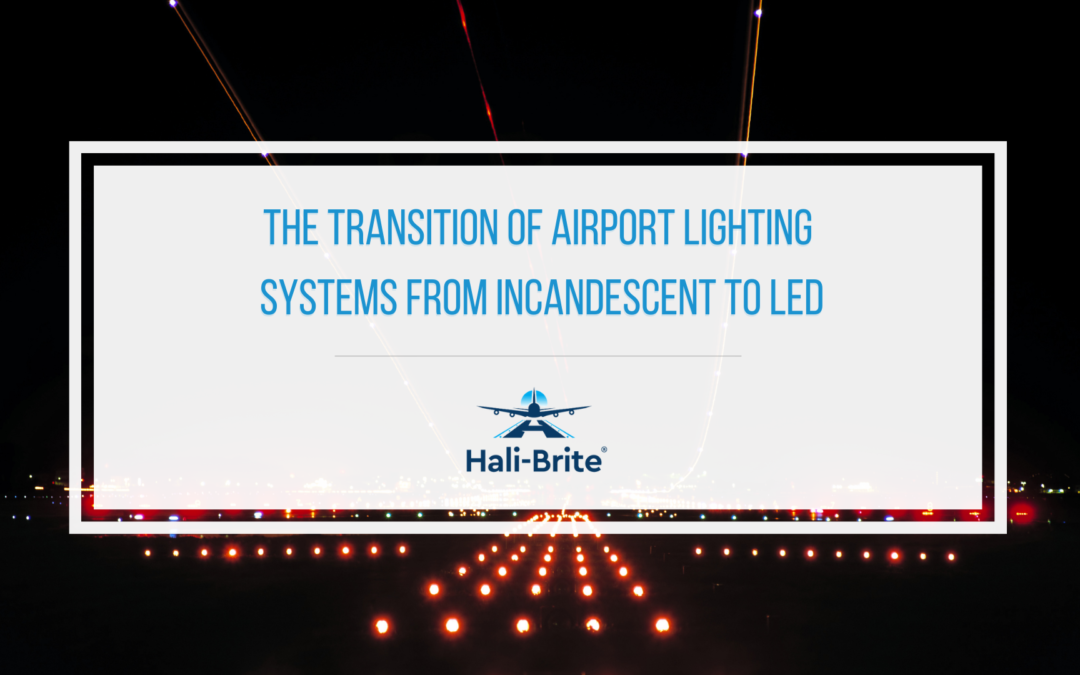For decades, incandescent lighting has been the standard choice for illuminating airport runways, taxiways, aprons, and signage. However, with advancements in lighting technology and growing concerns about energy consumption and environmental impact, airports worldwide are embracing the numerous benefits LED lighting systems offer.
In this article, we’ll explore the airport lighting transition from incandescent to LED, as well as the advantages of LED lighting and the impact it has on airport operations and sustainability.
- Incandescent Airport Lighting
- Introduction of LED Lighting Technology
- Advancements and Innovations in LED Airport Lighting
- Environmental Benefits of LED Airport Lighting
Incandescent Airport Lighting
In the early days of aviation, airport lighting systems consisted of individual incandescent bulbs installed along the edges of runways and taxiways. These bulbs were typically powered by direct current (DC) electricity and emitted a warm, yellowish light. The introduction of incandescent lighting in airports greatly enhanced visibility during nighttime operations and improved safety for pilots and ground personnel.
One of the main advantages of incandescent airport lighting is its ability to provide instant and intense illumination. When the power is supplied to an incandescent bulb, the filament inside it heats up and emits light. This immediate response allows pilots to quickly identify runways and taxiways, facilitating safer takeoffs, landings, and navigation around the airport.
However, incandescent lighting has gradually been phased out due to its relatively short lifespan and low energy efficiency. Incandescent bulbs typically have a lifespan of around 1,000 to 2,000 hours, which means they require frequent replacement. Furthermore, a significant portion of the electrical energy consumed by incandescent bulbs is converted into heat, resulting in wasted energy and higher electricity consumption. This inefficiency has prompted many airports to transition to more energy-efficient lighting options, such as light-emitting diodes (LEDs), which provide comparable or superior illumination while consuming significantly less power.
Introduction of LED Lighting Technology
In 2007, the Energy Independence and Security Act (EISA) was enacted in the United States, marking a pivotal moment in pursuing energy independence, security, and improved efficiency. This comprehensive legislation included provisions to promote the use of alternative, energy-efficient lighting solutions. Among these options, LED technology emerged as a particularly promising choice. Recognizing the potential benefits of LEDs, the Federal Aviation Administration (FAA) took a proactive approach by adopting a phased strategy to install and evaluate LED lighting in various airfield applications within the United States National Airspace System (NAS).
By transitioning from incandescent lighting to LEDs, the FAA seeks to optimize energy usage and reduce the environmental impact of airport lighting systems. LEDs produce a higher intensity of light while consuming less energy, resulting in improved illumination and substantial energy savings for airports. Furthermore, the implementation of LED lighting aligns with the FAA’s broader goals of operational efficiency and cost reduction. LEDs have a significantly longer lifespan compared to conventional incandescent bulbs, reducing the need for frequent replacements and lowering maintenance costs. Hali-Brite’s Airport LED Rotating Beacon, for example, can last up to 50,000 hours, which is significantly longer than traditional beacon lighting with a lamp life of only 1-3 years.
Advancements and Innovations in LED Airport Lighting
In addition to improved visibility, energy efficiency, and longevity, LED airport lighting systems have several noteworthy advancements and innovations that have further enhanced their effectiveness and functionality. Some of these include:
Adaptive Lighting Systems
LED airport lighting has seen the development of adaptive lighting systems that can dynamically respond to changing environmental conditions. These systems utilize sensors and intelligent controls to adjust the lighting levels based on ambient light, weather conditions, and aircraft movement. For instance, during low visibility conditions, the intensity of the LED lights can be increased to enhance pilot visibility, while during periods of reduced activity, the lighting levels can be dimmed to conserve energy.
Color Variation
LED technology allows for easy customization of airfield lighting colors, enabling airports to implement color-coded lighting schemes for various purposes. For example, specific colors can be used to designate different areas or operations, such as red lights to indicate the end of the runway for departing aircraft, blue lights for taxiway guidance, or green lights for aircraft landing threshold.
Centralized Monitoring and Control
LED airport lighting systems can be integrated into centralized monitoring and control systems. This allows airports to manage and monitor the entire lighting network from a central location, providing real-time status updates, automated fault detection, and remote control capabilities. Centralized control streamlines maintenance processes, enables efficient scheduling of lighting operations, and enhances overall airport lighting system management.
Environmental Benefits of LED Airport Lighting
LED technology plays a vital role in creating greener and more sustainable airport environments. LED airport lighting offers a range of environmental benefits, which include:
Reduced Greenhouse Gas Emissions
The energy efficiency of LED lights directly contributes to a reduction in greenhouse gas emissions. By consuming less electricity, LED airport lighting reduces the carbon dioxide (CO2) emissions associated with power generation.
Lower Light Pollution
LED lights offer precise light distribution and control, minimizing light pollution. The focused nature of LEDs ensures that light is directed where it is needed, reducing spillage into surrounding areas. This targeted illumination helps preserve the natural darkness of the night sky, minimizes disruption to nocturnal wildlife, and supports the well-being of nearby communities.
Extended Lifespan and Reduced Waste
The extended lifespan of LED airport lighting translates into fewer replacements, reducing the amount of waste generated from discarded bulbs. Additionally, LED lights are not made with hazardous materials like mercury, which is commonly found in fluorescent lighting systems.
Future Trends and Innovations in Airport Lighting
The introduction of LED lighting in airports has marked a significant advancement in the field of aviation illumination. LED airport lighting systems provide enhanced visibility, energy efficiency, durability, and other innovative features that contribute to safer and more efficient runway operations.
As technology evolves, further advancements can be expected, such as smart lighting systems that use artificial intelligence and machine learning algorithms to adjust lighting operations based on real-time data and predictive analysis. Such lighting systems can adapt to changing conditions, optimizing lighting levels, colors, and patterns for different operational requirements.
Other possibilities include the utilization of emerging technologies such as organic light-emitting diodes (OLEDs), which offer greater flexibility in design, improved light quality, and potentially more energy-efficient solutions. These innovations will drive airports towards sustainable practices, improved passenger experiences, and enhanced operational efficiency.
Along with the airport lighting evolution, Hali-Brite remains at the forefront, continuously innovating and producing cutting-edge lighting systems that are both energy-efficient and cost-saving. We offer a range of LED airport lighting solutions that strictly follow FAA standards, ensuring safety and efficiency. For your airport lighting needs, call us at (218) 454-0956 or contact us here.


